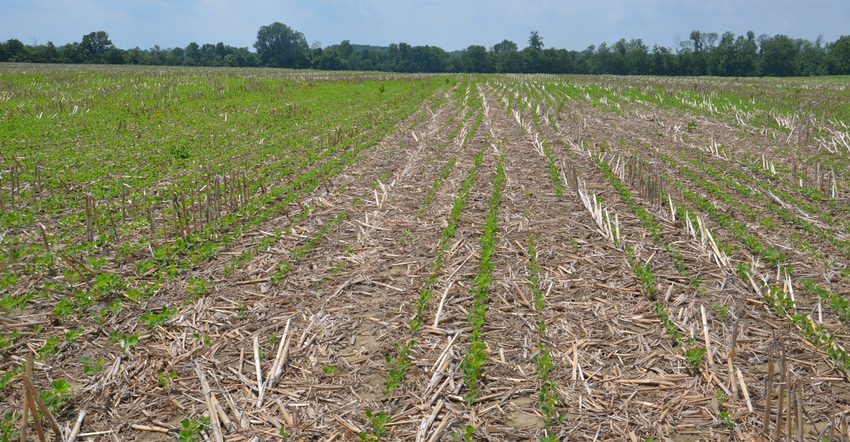
Steve Gauck walked across the Soybean Watch ’18 field, trowel in hand and the Purdue (University) Corn & Soybean Field Scouting Guide in his pocket. He made observations and looked for patterns as he walked the field.
“Overall, the field was in great shape,” Gauck says. He’s a sales agronomist for Beck’s, based near Greensburg, Ind. “The stand was uniform in spacing and growth stage. Plants were at the V2 growth stage.”
One thing Gauck noticed, however, was that every so often, there were narrow strips running at an angle where the stand wasn’t as thick. The field was no-tilled into cornstalks. In some of those narrow strips, he dug in and found some beans had broken their necks trying to emerge. The soil seemed harder there.
Pick up pattern
Gauck figured that it likely wouldn’t be a large hit on yield because the strips were narrow and in pairs, and a good distance apart. Soybeans compensate for missing plants, and he figured plants without close neighbors would fill in the gaps later. Still, it was a mystery worth solving. It might be something that could be avoided in the future.
That’s one of the purposes of Soybean Watch ’18, sponsored by Beck’s. The goal is to pick up ideas and observations in this field that might apply to your fields and might factor into decision-making in the future.
Gauck and the farmer walking with him began to speculate on what might have happened. Gauck first thought it might be tracks from the self-propelled sprayer. The field was sprayed after planting.
He concluded, however that the areas where emergence was affected are too close together to be from a self-propelled sprayer, and noted there were no definite track patterns like might have been left by a sprayer tire.
He began checking the distance between the paired sets of areas where emergence was affected. It was roughly 60 feet each time.
As they walked deeper into the field, the pattern disappeared. There were no strips of missing plants across the remainder of the field.
Find cause
Then things began to click for the operator. He recalled that they spread fertilizer broadcast over the top with a tractor and fertilizer cart on a 60-foot spread pattern. He also recalled that they started planting the field before a second person began spreading fertilizer. They originally had not intended to plant that field on that particular day, but weather and soil conditions caused an adjustment in plans.
“Driving over the soil just after planting with a loaded cart might explain it,” Gauck says. “That would be especially true here on this end, where the person started applying and the cart was full and heavier. It was apparently enough to pack the soil just enough so that beans had trouble making it through the soil.”
But why did the pattern stop partway across the field? The farmer’s face lit up. He recalled that the person spreading fertilizer caught up and moved ahead of the planter. The fertilizer pass was made ahead of planting on that side of the field.
“The rows weren’t pressed down after planting over there,” Gauck says. “Beans emerged normally. We will be flying a UAV [unmanned aerial vehicle] over the field later in the season, and it will be interesting to see if and how long these patterns are visible. It appears it was just a simple management thing that you wouldn’t think about causing an issue at the time.”
About the Author(s)
You May Also Like




